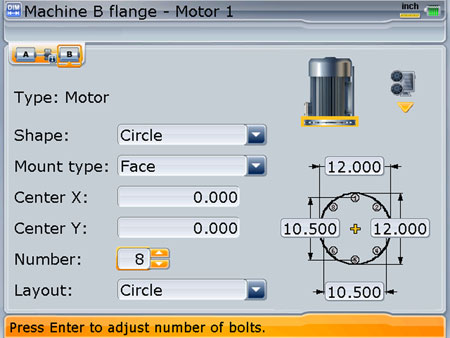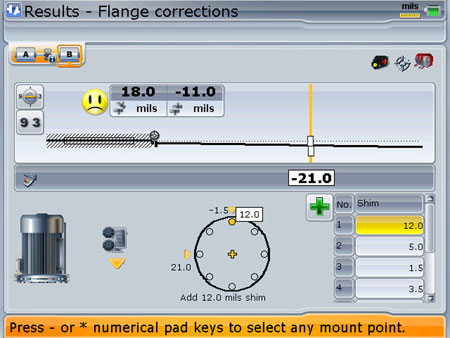Vertical pumps are a popular choice in the water industry because they provide many advantages. A vertical pump typically uses one-quarter of the floor space of a motor-driven horizontal pump. The driver is off the floor and less prone to flood damage. Since impellers are always submerged, they are self-priming and can start at full capacity.
Vertical pumps are designed to be "self-aligning" due to the rabbet fit between pump and driver, thus eliminating the need for precision shaft alignment. Notwithstanding these advantages, this article will focus on the need for alignment of vertical pumps.
Many assume that since the pump and driver have a rabbet fit that there is no misalignment. This is theoretically correct, since the excellent machining of the mating surfaces supposedly guarantees it. In practice, however, this is most often not true. Misalignment occurs on this type of drive as often as on horizontally mounted drive systems (Shaft Alignment Handbook, 3rd Edition, John Piotrowski, pg. 678).
Aligning this equipment to precision alignment tolerances will produce the same benefits that have long been proven to occur with horizontal drive machines, such as extended equipment life, increased efficiency and reduced vibration levels. With today's modern laser alignment systems, the process is greatly expedited, producing even greater savings through reduced labor costs
Consider the following when implementing an alignment program for vertical pumps.
Alignment Program Considerations
First, what technology will you use? Dial indicators have been a tried and true method alignment method for many years but have a steep learning curve and can be tedious under the best circumstances. Typical dial indicators have a resolution of .0001 in, but some modern laser alignment systems have 1 micron resolution. This resolution makes them extremely accurate while greatly simplifying and speeding up the precision alignment process with easy-to-understand graphical results and instructions that guide the user through the alignment process. They also provide reporting and documentation capabilities.

Figure 1. Motor flange setup screen from a laser tool for a vertical pump alignment application.

Figure 2. Results screen with shim corrections for flange bolt locations from a laser tool.
| Second, what are the radial clearances between the shaft and the pump housing or support structure? If a laser-based system is used, will the components and bracketing fit? Current laser alignment systems can function with as little as 3 in of radial clearance from the shaft and 90 deg rotation. |
| Third, has the pump ever been precision-aligned? With a vertical drive application, shimming at the driver's flange bolts corrects angular misalignment and sets the pump shaft and driver shaft parallel. Once the shafts are parallel, moving the driver laterally corrects for offset misalignment. This may require that the typically tight rabbet fit clearances meant to ensure proper alignment be machined and opened to allow for movement of the driver relative to the pump. This is often the case on vertical pump applications and can be accomplished by either machining the driver flange, or machining the pump housing or support structure flange. |
Another consideration is what coupling type is used. Vertical applications that use flexible style couplings are the most straightforward. Multistage vertical turbine pumps have rigid type couplings. When installed, this coupling type not only transfers torque from the driver to the pump, but it is also adjusted axially to "lift" the entire pump shaft assembly to set the impeller clearances in the bowl. Once the proper lift is set for impeller clearances, the coupling is assembled and becomes rigid. In other words, there is no flex once the coupling is installed. Even these types of alignments can be expedited in a timely manner with some of today's laser systems.
| Cardan shafts are a popular coupling choice for vertical applications in the water industry. Cardan shafts differ from conventional couplings in that they have a u-joint on either end of the coupling spacer and can accommodate large offsets between pump and driver. They function just like the drive shaft on an automobile. What is critical in cardan shaft alignment is the angularity at each flex plane, not offset. The pump and driver shaft must be parallel, but have intentional offsets to create angles at the u-joints to ensure proper lubrication of the needle bearings in the u-joint. With the use of cardan type brackets, even this typically difficult alignment is expedited with modern laser alignment systems. |
Conclusion |
| Typical industries that use vertical pumps include oil refineries, water treatment plants, pond lift station pumps and paper mills. Some cooling towers also feature vertical pump applications. The commitment to implement precision laser alignment of vertical pump applications can be justified in part by the positive feedback and benefits of similar successful programs for horizontal drive applications. It must have the support of management and properly trained personnel, and involve the right laser alignment system. |
| Everyone involved in implementing a precision vertical alignment program must understand that modifications may have to be made to existing equipment before the alignment can be effected. Rabbet fits may need to be machined to increase clearances and allow for offset misalignment correction. When a motor or pump that has not been previously laser aligned goes for repairs, the rabbet fits should be machined to increase clearances so that eventual alignment corrections can be made. Jacking bolts should also be installed on the support structure in the four chosen cardinal directions to facilitate the alignment process. |
The benefits of precision alignment of vertical pump applications far outweigh the initial cost of the preparation needed to allow for necessary alignment corrections. This initial cost is typically a one-time event, unless the driver or pump housing rabbet fits are rebuilt or equipment is replaced. Increased equipment life means less unscheduled downtime. A smoother running machine means greater efficiency and energy savings. This alone can justify precision alignment of vertical pumps. How much money are poorly aligned vertical machines costing you?
Pumps & Systems, February 2010


